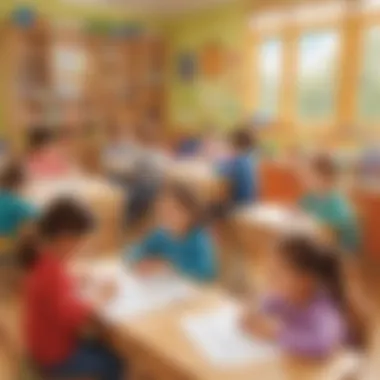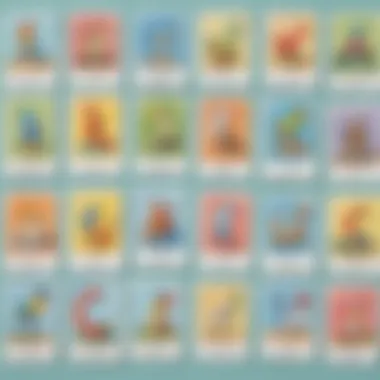Engaging Activities to Master Letter Sounds for Kids


Intro
Learning letter sounds forms a crucial building block in a child's literacy journey. It would be essential for anyone involved in teaching or parenting to foster an environment where phonemic awareness can flourish. This early stage in reading is not merely about memorizing sounds, but also about connecting those sounds with letters and words. Engaging activities make this foundational process enjoyable and effective.
Through tailored exercises, such as crafts, quizzes, and articles, children from ages five to twelve can explore letter sounds in ways that catch their interest. These age-friendly strategies not only aid in comprehension but also nurture a lasting enthusiasm for reading.
Creative Activities
Engaging engaging activities tailored for letter sounds learning help establish early literacy skills in children. An array of creative crafts can offer hands-on experiences related to different letters.
Craft Ideas
These are some simple craft ideas to implement:
- Sound Collages: Gather images or real-world items that start with specific letter sounds. This allows children to visually connect letters with sounds.
- Alphabet Puppets: Children can create puppets representing each letter. Utilizing these puppets in storytelling can enhance remembering sounds associated with the letters.
- Letter Stones: Painting stones with different letters can provide tactile encounters. Children can sort these stones or even create words.
Step-by-Step Guides
For successful implementation, here is a step-by-step guide on one activity:
- Choose a Letter: Aim for one letter each time.
- Gather Materials: Collect images and small items relevant to that letter.
- Create the Collage: Have children glue down the images onto a sheet of construction paper.
- Discuss Sounds: Reinforce learning by asking about the sound the letter makes while looking at items glued down.
Educational Value
By fostering creativity through crafts, children naturally explore sound connections in a playful environment. This approach enhances fine motor skills, boosts cognitive development, and integrates kinesthetic learning methods, all centered around literacy.
Fun Quizzes
Fun quizzes offer an interactive way for children to reinforce their knowledge of letter sounds.
Quiz Topics
Activities can encompass:
- Vowel sounds
- Consonant blends
- Initial sounds in words
Question Types
Presenting various question formats keeps children engaged while testing their skills. Quiz might include:
- Multiple Choice Questions: Selecting the right picture or answer related to the sound.
- Fill in the Blanks: Writing missing letters in words.
- Sound Identification: Listening for a sound and selecting corresponding images.
Knowledge Reinforcement
Quizzes help children grasp their understanding while stimulating their recall abilities. The interactivity provides them opportunities to apply learned sounds in practical contexts, enhancing retention of knowledge.
Fact-Based Articles
Informative articles on letter sounds can play an instrumental role in supporting learning.


Topics
These articles may cover themes related to:
- Phonetics and phonemic awareness
- The importance of early literacy skills
- Tips for parents in fostering reading
Engaging Content
Ensuring comprehension, articles present information simply yet engagingly. Simple lists, clear visuals, and straightforward language can reach varying literacy levels among both children and adults.
Preface to Letter Sounds
Learning letter sounds is a fundamental building block in a child's literacy development. When children understand the sounds associated with letters, they gain a crucial skill in phonemic awareness, which is vital for reading fluency. This section explores the basic components of letter sounds, and the significance they hold in a child's educational journey.
Understanding Phonemic Awareness
Phonemic awareness refers to the ability to recognize and manipulate individual sounds in spoken words. This is not the same as phonics, which involves linking sounds to written letters. Phonemic awareness focuses solely on auditory skills.
In young children, developing phonemic awareness can be approached through enjoyable activities. The more they engage with sounds, the more they can decipher letters associated with those sounds. For example, when a child learns the sound of the letter
Interactive Activities at Home
Interactive activities at home play a crucial role in reinforcing letter sounds for elementary school children. Engaging children in play-based sound learning situates skills within their daily life experiences. These activities allow young learners to develop phonemic awareness in a relaxed and enjoyable environment. This method encourages curiosity about language and ultimately builds confidence in reading tasks. Moreover, such activities provide opportunities for creativity. Children are more likely to remember concepts when they are related to hands-on learning. Family involvement also becomes a factor, fostering connections between home and learning.
Sound Identification Games
Sound identification games can significantly boost children's letter recognition and endurance in phonetic learning. By turning letter sounds into a fun game, children can encounter practical learning situations everywhere, increasing retention. Here are some game suggestions:
- Mystery Sound Box: Place various objects in a box, and have children listen to their sounds before naming the item associated with the first sound.
- Sound Bingo: Create bingo cards featuring different letter sounds. Instead of numbers, call out sounds, and as children recognize sounds, they mark them off.
These more vibrant types of sound games help maintain interest and motivate further explorations in sounds. They lead children to increase their engagement with letters when experiencing playful feedback during learning.
Creating Letter Sound Flashcards
Creating letter sound flashcards works very well as an effective visual memory technique. Building personalized flashcards allows children to connect letters with familiar ideas and things surrounding them. Parents or caregivers can guide their children in the process.
- Include pictures that illustrate items beginning with each letter sound. For example, combine the letter 'B' with visuals of ‘Ball’, ‘Bear’, and 'Bicycle'.
- Encourage interactive learning by naming the item on the flashcard as children draw or color it.
Such methods encourage continuous practice and recognition during daily routines. Regular use of flashcards fosters mental agility and supports letter-level comprehension while also enhancing vocabulary.
Everyday Objects Sound Scavenger Hunt
Conducting a sound scavenger hunt with everyday objects ignites excitement. It makes learning dynamic and connects letter sounds to the child's immediate environment. Parents can engage children by asking them to locate various items that correspond to different letters of the alphabet around the house or outside.
For instance:
- The letter ‘K’ might be represented by keys, kettle, or cat.
- For the letter R, look for rubber bands, rings, or rocks.
Highlighting sound association with familiar or common items aids in vortexing phonemic skills naturally. This blend of adventure and practical experience solidifies understanding while ensuring that learning becomes intertwined with daily activities.


"By incorporating sound identification games, flashcard practices, and interactive scavenger hunts, parents can provide multiple pathways for their children to engage in the intricacies of letter sounds."
School-Based Activities
School-based activities play a vital role in orchestrating learning experiences that are tailored for the kindergarten to elementary school years. Implementing systematic approaches to phonics in a classroom fosters an environment rich in phonemic awareness. This awareness is foundational for visible improvements in reading and writing skills. Teachers and educators can engage students through interactive activities targeted to make learning enjoyable and effective.
The strategic design of these activities encourages participation and evokes curiosity among students. Such dynamics can strengthen their self-confidence and promote a lifelong passion for literacy. The incorporation of fun, multifaceted learning experiences contributes positively to diverse learning styles, making phonics more accessible.
Phonics Stations
Phonics stations are a cornerstone of effective phonics instruction in schools. These small learning hubs can accommodate a variety of engaging activities that rotate according to schedule.
Each station may include:
- Interactive letter sound games
- Phonic matching cards
- Sound recording devices for feedback
Creating phonics stations allows for both guided and independent exploration. This set-up helps students internalize letter sounds through repetition and varied contexts. Peer-to-peer interaction can also enhance learning outcomes, allowing children to teach each other while reinforcing their phonics skills.
Group Reading with Sound Emphasis
Facilitating group reading with an emphasis on sound not only promotes phonemic awareness but builds fluency. During these sessions, educators explicitly model pronunciation, inflection, and expression related to letter sounds, providing auditory benchmarks for children.
By selecting stories and texts filled with repetitive phonetic structures or prominent sound patterns, facilitators can enhance learner engagement. For example, using literary works where letter sounds are pronounced repeatedly can reinforce familiarity and ensure that children listen for sounds amid storytelling.
Additional Ideas:
- Consider segmenting sentences while highlighting different sounds.
- Encourage students to clap for each sound they hear.
- Introduce questions about the story that engage other cognitive skills while touching on sound awareness.
Singing Songs that Focus on Sounds
Utilizing songs that incorporate specific letter sounds presents an enjoyable way to learn phonics in the classroom. Music is a powerful tool in educational settings, especially for young learners. Those with compelling yet simple lyrics highlighting individual letter sounds serve dual purposes: promoting enjoyment and reinforcing learning.
Participating in singing activities activates multiple areas of learning; children practice phonemic awareness and enhance recall through melody. Furthermore, timing of exercises blending singing with kinesthetic movements (such as actions to match lyrics) can solidify engagement, making it easier for students to remember sounds associated with letters.
Teachers can select songs like those in the “Letterland” program which provide rhythmic and phonetic reinforcement, creating a harmony of learning through sound.
Phonics instruction can be exciting and vibrant. Bridges between sound and meaning are fostered when every activity is infused with rhythm and creativity.
In sum, school-based activities represent a spectrum of opportunities to delve into letter sounds. These activities not only prioritize foundational literacy but cultivate a stimulating learning environment tailored for new learners.
Outdoor Learning Activities
Outdoor learning activities are a vital component in teaching letter sounds. Engaging children in fresh air and nature not only promotes physical activity but also enhances their learning experience. These activities provide responsive and interactive environments that stimulate children's curiosity and foster phonemic awareness. The natural settings challenge kids to connect what they learn in the classroom with the world around them, thus making the process of learning letter sounds more organic and holistic.
Incorporating outdoor learning presents a few considerations:
- Environmental Awareness: Being outdoors raises awareness of surroundings which can be linked to words, sounds, and letters.
- Interactive Learning: Activities are often hands-on, urging children to explore and discover actively rather than passively absorbing information.
- Engagement and Enjoyment: Kids usually find outdoor activities exhilarating, leading to heightened engagement and decreased distractions.
Sound Bubbles


Sound bubbles are a playful yet instructive activity focusing on letter sounds. This activity encourages children to recognize sounds associated with specific letters by blending sensory engagement with movement. To begin with, teachers or caregivers can prepare bubbles for the activity by using bubble solutions. As the bubbles circle in the air, children can attempt to catch them while vocalizing letter sounds related to those letters displayed on nearby cards. For instance, calling out “B” as a bubble floats might help kids connect the sound to the letter physically.
Here are a few things to note:
- Materials Needed: Bubble solution and bubble wands, letter cards.
- Floor Plan: A clean outdoor area with enough space for the comfort of movement.
- Involvement Memory: The interplay allows children to physically embody the act of learning, cementing phonemic connections.
Consider also keeping track of letters and sounds practiced during the session, creating milestones in learning through playful scoring.
Nature Sound Walks
Nature sound walks offer an immersive experience that links outdoor exploration with auditory learning. During these walks, children can listen to various sounds in their environment, and correspond them with the appropriate letters. For eksempel, the sound of leaves rustling can be linked to
Digital Tools for Learning Letter Sounds
The inclusion of digital tools in literacy education marks a crucial evolution in methods faced in phonemic awareness. Technology has provided accessible resources that cater to various learning styles and paces. Digital tools such as apps and online games allow children to engage with letter sounds in interactive ways. This interactivity facilitates retention and comprehension as children enjoy the process of learning.
Educators and parents often welcome the flexibility digital platforms can provide. Beyond traditional teaching methods, these tools help keep children motivated. Many applications incorporate animations and sound effects that appeal to young learners. They also allow parents to track progress at their own convenience.
Parental Involvement in Learning
Parental involvement plays a critical role in the development of literacy skills in children. Engaged parents positively influence their child's attitude toward learning, particularly in the area of letter sounds. This involvement reinforces concepts taught in school and enhances the overall educational experience.
Several studies show that children with active parental support often achieve better academic outcomes. Active engagement provides children with a strong foundation in early literacy, and this foundation is established through various strategies and consistent practice.
Reading Together and Sound Practice
Reading together is one of the most effective strategies for strengthening a child's understanding of letter sounds. Parents can select age-appropriate books and customize their reading sessions to emphasize sounds and phonics. As they read, adults should draw attention to individual letters and sounds, making the activity interactive.
- Modeling Sounds: Parents can demonstrate the sounds each letter makes and encourage their child to replicate them. This can be as simple as pointing to the letter and saying its sound.
- Repetition: Repetition helps young children reinforce their understanding. Reading the same book multiple times can aid children in recognizing letter sounds.
- Ask Questions: Parents can ask their children to identify sounds at the beginning of words. This exercise trains the child’s listening skills and aids in their phonemic awareness.
Encouraging Sound Exploration at Home
Creating a home environment rich in sound exploration is essential for learning letter sounds effectively. Parents can introduce engaging games and activities that spotlight phonics in everyday life.
- Sound Games: Simple sound matching or sorting games can exemplify effective learning. Parents can create personalized tools using various household items.
- Listening Activities: Encouraging children to listen to everyday sounds and identify their corresponding letters can enhance their phonemic recognition. This may include sounds from toys or instruments.
- Incorporate Play: Utilize games that involve sound to create a fun learning environment. For example, using toys to represent words that start with the same letter sound can be engaging.
By implementing these strategies, parents nurture a deeper connection with their children's learning journey. Emphasizing the importance of letter sounds in a consistent manner helps ensure that children grasp foundational literacy skills.
Involvement of parents elevates a child's development in phonetic awareness and reading proficiency.
Epilogue
Summarizing the Importance of Letter Sounds
Letter sounds are the building blocks of language. Early understanding of these sounds lays a foundation that is crucial as children progress in their literacy journey. Mastery of phonemic awareness allows children to decode words, significantly enhancing their reading skills. Engaging with letter sounds positively affects children’s reading fluency, comprehension, and ultimately, their overall confidence in language.
With a strong grasp of letter sounds, children can identify patterns in language. This helps them spell correctly, recognize sight words more readily, and enhances their verbal expression. Moreover, learning these foundational skills in a playful environment encourages a love for learning, which can last a lifetime.
In brief, the emphasis on letter sounds ensures children are well-equipped for academic success.
Next Steps for Continued Learning
To foster further development in letter sounds, continual exposure and practice is necessary. Parents and educators can take proactive steps to integrate sound learning into daily activities. Here are some strategies that can enrich sound recognition:
- Daily Reading: Encourage habitual reading of varied texts. This not only exposes children to different sounds but enables context-based learning.
- Create a Sound Journal: Ask children to document new sounds they learn from different sources. This creates a sense of ownership over their learning progress.
- Participate in Sound-Based Activities: Regular practice of the activities discussed earlier keeps the excitement alive. Make it engaging and own it.
- Embrace Mistakes: Learning through trial and error is essential. Praise effort regardless of outcomes; it encourages persistence.
Next, act as a facilitator of learning. Engage in discussions about sounds, play games focused on phonetics, and remain supportive. Building literacy takes time, and instilling confidence ensures sustaining efforts toward effective language mastery.







